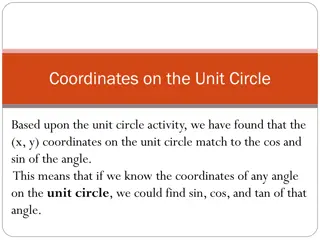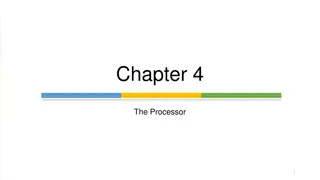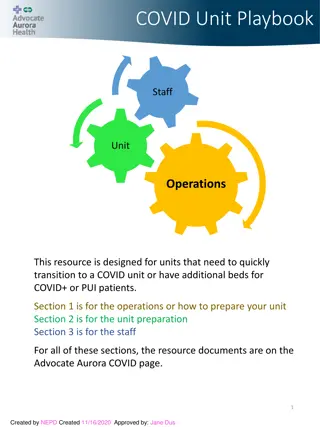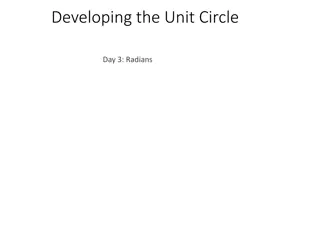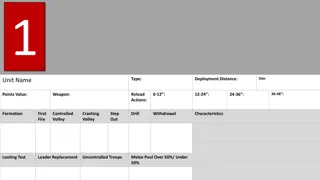
Understanding Semiconductor Memory Types and Architectures
Explore the basics of semiconductor memory types like DRAM and SRAM, their usage in different applications, and the working principles behind dynamic and static RAM architectures.
Download Presentation

Please find below an Image/Link to download the presentation.
The content on the website is provided AS IS for your information and personal use only. It may not be sold, licensed, or shared on other websites without obtaining consent from the author. Download presentation by click this link. If you encounter any issues during the download, it is possible that the publisher has removed the file from their server.
E N D
Presentation Transcript
Semiconductor Main memory The two basic forms of semiconductor random access memory are : Dynamic RAM (DRAM) (SRAM). SRAM is faster and more expensive than DRAM. SRAM is used for cache memory. DRAM is used for main memory. and static RAM
Semiconductor Main memory The two basic forms of semiconductor random access memory are : Dynamic RAM (DRAM) (SRAM). SRAM is faster and more expensive than DRAM SRAM is used for cache memory. DRAM is used for main memory. and static RAM
Semiconductor Memory Types Memory Type Category Erasure Volatility Random-access memory (RAM) Read-write memory Electrically, byte-level Volatile Read-only memory (ROM) Read-only Memory [Write can not possible] Not possible Programmable ROM (PROM) Erasable PROM (EPROM) UV light, chip-level Nonvolatile Read-mostly memory [Write can be possible] Electrically Erasable PROM (EEPROM) Electrically, byte-level Flash memory Electrically, block-level
DRAM A dynamic RAM (DRAM) is made with such cells that store data as charge on capacitors. The presence or absence of charge in a capacitor is interpreted as a binary 1 or 0. Because capacitors have a natural tendency to discharge, dynamic RAMs require periodic refreshing to maintain data storage. The term dynamic refers to this tendency of the stored charge to leak away, even with power continuously applied. The transistor acts as a switch that is closed (allowing current to flow) if a voltage is applied to the address line and open (no current flows) if no voltage is present on the address line.
DRAM For the write operation, a voltage signal is applied to the bit line, allowing a charge to be transferred to the capacitor. A high voltage represents 1, and a low voltage represents 0. For the read operation, a voltage signal is applied to the address line, the transistor turns on and the charge stored on the capacitor
SRAM In a SRAM, binary values are stored using traditional flip-flop logic-gate configurations A static RAM will hold its data as long as power is supplied to it. Four transistors(T1,T2,T3 & T4) are cross connected in an arrangement that produces a stable logic state. In logic state 1, point C1 is high and point C2 is low; in this state,T1 and T4 are off and T2 and T3 are on. In logic state 0, point C1 is low and point C2 is high; in this state,T1 and T4 are on and T2 and T3 are off. Unlike the DRAM, no refreshing is needed to retain data.
ROM Read Only Memory (ROM) contains a permanent pattern of data that cannot be changed. A ROM is nonvolatile; that is, no power source is required to maintain the bit values in memory. While it is possible to read a ROM, it is not possible to write new data into it.
Types of ROM[1/3] 1] PROM(Programmable ROM) :- The PROM is nonvolatile and may be written into only once. For the PROM, the writing(programming) process is performed electrically and by the supplier itself. 2] Erasable Programmable read-only memory (EPROM) In this read and written done electrically same as with PROM. However, before a write operation, all the storage cells must be erased to the same initial state by exposure of chip to ultraviolet radiation. EPROM is more expensive than PROM, but it has the advantage of the multiple update capability. Major Drawback is selective erasing is not possible.
Types of ROM[2/3] 3] Electrically Erasable Programmable read-only memory (EEPROM/ E2PROM) :- This is a read-mostly memory that can be written into at any time without erasing prior contents In this read and written done electrically same as with PROM. Here, for erasing process instead ultraviolet radiation electrically erasing is used which reduces cost to some extent. Major advantages are possible(byte) and before a write operation, no need to erase storage cells. selective erasing is
Types of ROM[3/3] 4] Flash memory:- Another form of semiconductor memory is flash memory (so named because of the speed with which it can be reprogrammed) Flash memory uses an electrical erasing technology. An entire flash memory can be erased in one or a few seconds, which is much faster than EPROM In addition, it is possible to erase just blocks of memory rather than an entire chip(Selective erasing is possible). Flash memory is intermediate between EPROM and EEPROM in both cost and functionality.

